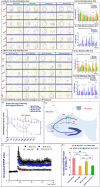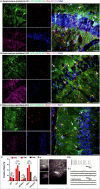Rebuilding hippocampus neural circuit with hADSC-derived neuron cells for treating ischemic stroke
- PMID: 35379347
- PMCID: PMC8981707
- DOI: 10.1186/s13578-022-00774-x
Rebuilding hippocampus neural circuit with hADSC-derived neuron cells for treating ischemic stroke
Abstract
Background: Human adipose-derived stem cells (hADSCs) have been demonstrated to be a promising autologous stem cell source for treating various neuronal diseases. Our study indicated that hADSCs could be induced into neuron-like cells in a stepwise manner that are characterized by the positive expression of MAP2, SYNAPSIN 1/2, NF-200, and vGLUT and electrophysiological activity. We first primed hADSCs into neuron-like cells (hADSC-NCs) and then intracerebrally transplanted them into MCAO reperfusion mice to further explore their in vivo survival, migration, integration, fate commitment and involvement in neural circuit rebuilding.
Results: The hADSC-NCs survived well and transformed into MAP2-positive, Iba1- or GFAP-negative cells in vivo while maintaining some proliferative ability, indicated by positive Ki67 staining after 4 weeks. hADSC-NCs could migrate to multiple brain regions, including the cortex, hippocampus, striatum, and hypothalamus, and further differentiate into mature neurons, as confirmed by action potential elicitation and postsynaptic currents. With the aid of a cell suicide system, hADSC-NCs were proven to have functionally integrated into the hippocampal memory circuit, where they contributed to spatial learning and memory rescue, as indicated by LTP improvement and subsequent GCV-induced relapse. In addition to infarction size shrinkage and movement improvement, MCAO-reperfused mice showed bidirectional immune modulation, including inhibition of the local proinflammatory factors IL-1α, IL-1β, IL-2, MIP-1β and promotion proinflammatory IP-10, MCP-1, and enhancement of the anti-inflammatory factors IL-15.
Conclusion: Overall, hADSC-NCs used as an intermediate autologous cell source for treating stroke can rebuild hippocampus neuronal circuits through cell replacement.
Keywords: Adipose-derived stem cells (ADSCs); Middle cerebral artery occlusion (MCAO); National Institute of Health Stroke Scale (NIHSS); Rogers scale system; hADSC-derived neuron-like cells (hADSC-NCs).
© 2022. The Author(s).
Conflict of interest statement
The authors declare no competing interests.
Figures







References
-
- Albers GW, Diener HC, Grind M, Halperin JL, Horrow J, Olsson SB, Petersen P, Vahanian A, Frison L, Nevinson M, et al. Stroke prevention with the oral direct thrombin inhibitor ximelagatran compared with warfarin in patients with non-valvular atrial fibrillation (SPORTIF III): randomised controlled trial. Lancet. 2003;362:1691–1698. - PubMed
-
- Blecker D, Elashry MI, Heimann M, Wenisch S, Arnhold S. New insights into the neural differentiation potential of canine adipose tissue-derived mesenchymal stem cells. Anat Histol Embryol. 2017;46:304–315. - PubMed
-
- Chen AZ, Liu N, Huang H, Lin FF, Liu DS, Lin XH. Outgrowth of neuronal axons on adipose-derived stem cell transplanting for treatment of cerebral infarction in rats. Chin J Cell Mol Imm. 2011;27:868–871. - PubMed
Grants and funding
- 2017YFE0121100/the ministry of science and technology of china
- 2016YFE0107200/the ministry of science and technology of china
- 2018ZX09201002-005/the national major scientific and technological special project for "significant new drug development"
- 31601102/the national natural science foundation of china
- 81461138037/the national natural science foundation of china
- 31471029/the national natural science foundation of china
- 31671055/the national natural science foundation of china
- 81801262/the national natural science foundation of china
- 18410760100/the shanghai science and technology foundation
- 16ZR1446900/the shanghai natural science foundation
- 17ZR1416200/the shanghai natural science foundation
- ZR2019MH074/Natural Science Foundation of Shandong Province
- 2018ZHGY089/Key Research Project of Yantai City
- 202005AF150050/Xujun's Expert Work Station
LinkOut - more resources
Full Text Sources
Miscellaneous

